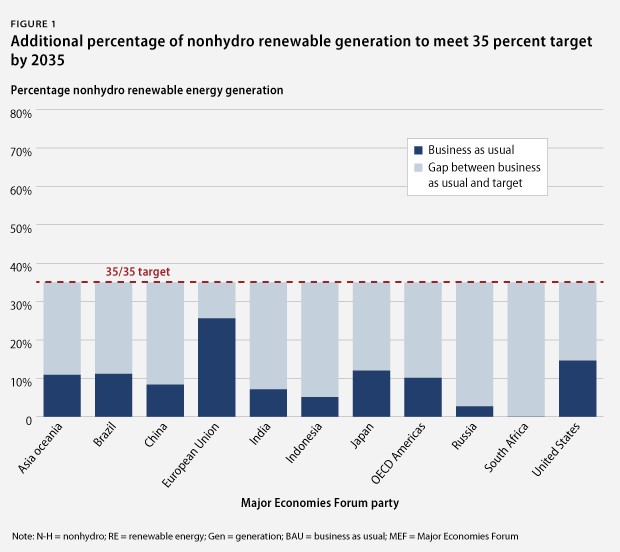Carbon Energy Target by 2035 for the World's Largest Economies
 The Center for American Progress (CAP) has released a proposal for the Major Economies Forum to adopt a 40 percent zero-carbon electricity target by the year 2035. The forum includes the world’s 17 largest carbon emitters, who together account for 80 percent of the world’s greenhouse gas emissions.
The Center for American Progress (CAP) has released a proposal for the Major Economies Forum to adopt a 40 percent zero-carbon electricity target by the year 2035. The forum includes the world’s 17 largest carbon emitters, who together account for 80 percent of the world’s greenhouse gas emissions.The CAP report, entitled ” 40×35: A Zero-Carbon Energy Target for the World’s Largest Economies,” illustrates that meeting this target is not only highly feasible but, if met, would reduce cumulative CO2 emissions reductions 6.4 gigatons by 2035.
“The world needs to double current commitments to reducing dangerous greenhouse gas emissions by 2020 to have any hope of achieving a meaningful level of climate safety in the long run,” said Andrew Light, co-author of the report and Senior Fellow and Director of International Climate Policy at the Center for American Progress.
“Unfortunately, most efforts are now focused on creating a new global climate treaty which wouldn’t go into effect until 2030. An embrace of CAP’s 40×35 proposal for the coming action agenda for the Major Economies Forum would be an important step toward reducing emissions in the near term among a smaller group of countries while the larger negotiations continue.”
The overall objective of the report is to find the ideal emissions target and timeframe for the largest number of parties. The analysis shows how difficult it would be for each party to hit the target, and the total CO2 emissions reductions if the target was achieved.
These scenarios explore variations that would include renewables, hydro electricity, and nuclear power, or only subsets of these three. The CAP authors concluded that the 40×35 target would lock in already expected CO2 reductions by 2035 and improve them by 12 percent.
Of the four scenarios examined in this study, the 40×35 target is also the most politically viable. This is due to greater ambition sharing and overall carbon reductions by both developed and developing countries.
None of the parties to the Major Economics Forum currently have national zero carbon electricity targets for 2035. Embracing the goal would help to prevent backsliding from anticipated business as usual carbon reductions due to changes in fuel costs, or currently unforeseen policy shifts in these countries.
Finally, if this target were embraced, a set of companion commitments could be made among parties to expand the renewable electricity sector, cooperate on technology development and deployment, and strengthen existing bilateral energy agreements.

Pairing such a zero-carbon electricity target with an energy efficiency goal would create more sustainable, smart energy systems in countries likely to see a surge in electricity demand over coming years and enable them to more easily reach the target with reduced consumption.
Light added, “Embracing the 40×35 target is certainly not the only thing we need to do-nor is it sufficient to close the ambition gap we currently face-but it is achievable, and at this point absolutely necessary so that the new global treaty in the making doesn’t wind up only overseeing a world that has shot past dangerous levels of temperature increase.”
You can return to the main Market News page, or press the Back button on your browser.

